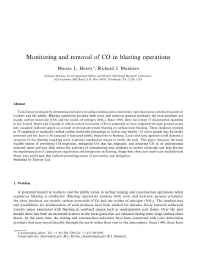Mining Publication: Monitoring and Removal of CO in Blasting Operations
Original creation date: December 2008
Authors: ML Harris, RJ Mainiero
Toxic fumes produced by detonating explosives in surface mining and construction operations pose potential hazards to workers and the public. Blasting operations produce both toxic and nontoxic gaseous products; the toxic products are mainly carbon monoxide (CO) and the oxides of nitrogen (NOx). Since 1988, there have been 17 documented incidents in the United States and Canada in which carbon monoxide (CO) is suspected to have migrated through ground strata into occupied enclosed spaces as a result of proximate trench blasting or surface mine blasting. These incidents resulted in 39 suspected or medically verified carbon monoxide poisonings as well as one fatality. At worst people may be fatally poisoned and the least to be expected is increased public objections to blasting. Local and state agencies could demand a cessation of the blasting requiring more expensive mechanical means to break the rock. This paper discusses the most feasible means of preventing CO migration, mitigating CO that has migrated, and detecting CO in an underground enclosed space and may help reduce the exposure of unsuspecting area residents to carbon monoxide and help prevent the implementation of unnecessary regulations and limitations on blasting. Single-hole shots and small-scale multiple-hole blasts were performed that indicate promising means of prevention and mitigation.

- Blasting and Explosives
- CO Migration from Trench Blasting in Amherst, New York
- Dangers of Toxic Fumes from Blasting
- Factors Affecting ANFO Fumes Production
- Field Studies of CO Migration from Blasting
- Hybrid Fiber-Optic Electrochemical Carbon Monoxide Monitor
- Remote Monitoring of Mine Seismicity and Earthquakes Using Radio Telemetry, Computers, and the Internet
- Safer Mine Hoisting With Conveyance Position and Load Monitoring
- Smoke, Carbon Monoxide, and Hydrogen Chloride Production from the Pyrolysis of Conveyor Belting and Brattice Cloth
- Technology News 488 - Migration of Blasting Fumes into a Western Pennsylvania Home
- Toxic Fume Comparison of a Few Explosives Used in Trench Blasting